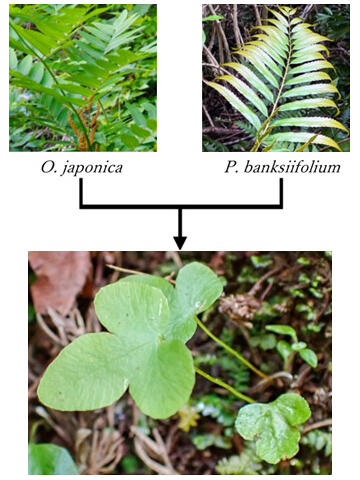Approximately 10,000 species of ferns are known, with new species being created through repeated hybridization. However, the Osmundaceae, a representative family of ferns, is less prone to hybridization, and there is no evidence of its repeated hybridization in the past. In fact, there are only five reported cases of natural hybrids in the current Osmundaceae family. Moreover, two of these hybrids are very small populations, growing in only one location each, and one hybrid is already extinct.
A research group led by Professor Satoshi Nanami and Graduate Student Tomohiro Ueshima of the Graduate School of Science at Osaka Metropolitan University and Professor Toshihiro Yamada of the Graduate School of Science at Hokkaido University speculated that the reason for the failure to find hybrids was that "it is impossible to create a hybrid between Osmunda japonica and Plenasium banksiifolium in the first place." In response to this, they conducted experiments to artificially cross the two plants and found that hybrids could be produced very easily. Using the morphological characteristics of the artificial hybrids as a clue, the research group searched for natural hybrids in Miyazaki Prefecture and found several individuals of small, presumed hybrids. Genetic testing confirmed that these individuals were indeed hybrids between O. japonica and P. banksiifolium. The results have been published in the journal Acta Phytotaxonomica et Geobotanica.

Provided by Osaka Metropolitan University
During the experiments to create artificial hybrids, the research group recorded the growth of the individuals after germination and examined the number of leaves and their characteristics. Through comparison of the results, they estimated that all natural hybrids found were less than a year old, or a few months old at most, after germination. However, larger individuals were not found at all.
In other words, although the experiments indicated that hybrids between O. japonica and P. banksiifolium can be produced, they may die early after germination in the natural environment. This is probably the reason why there are few reports of hybrids and not much speciation due to plant hybridization in the Osmundaceae.
It is customary to give newly discovered natural hybrids a new scientific name. However, the research group decided not to give this hybrid a new name because it is extremely short-lived and will soon become extinct.
Yamada said, "I was very surprised to find a new hybrid species of Osmundaceae in the field. If the mechanism of new species formation can be clarified, it may lead to the creation of new crops. The Botanical Gardens of Osaka Metropolitan University is conducting research on extinction, and we hope that the discoveries made will also provide clues to understanding the extinction of hybrid species."
Journal Information
Publication: Acta Phytotaxonomica et Geobotanica
Title: Natural Hybrids between Osmunda japonica and Plenasium banksiifolium (Osmundaceae) and the Implications for Reproductive Barriers
DOI: 10.18942/apg.202311
This article has been translated by JST with permission from The Science News Ltd. (https://sci-news.co.jp/). Unauthorized reproduction of the article and photographs is prohibited.




